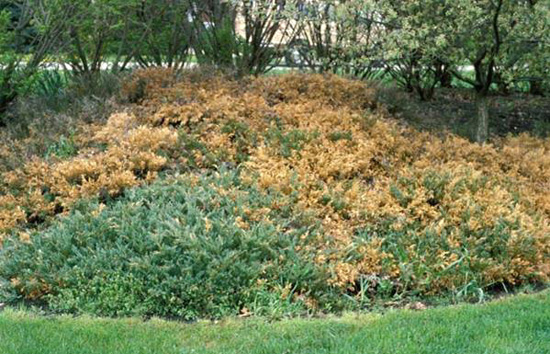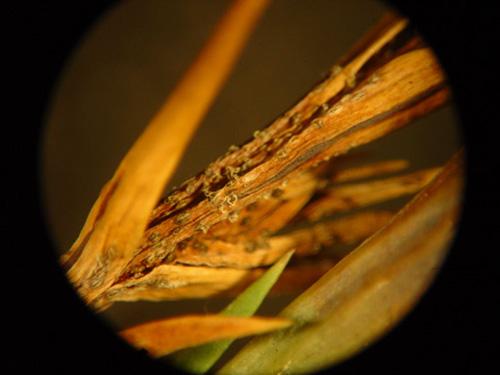Issue 7, June 5, 2009
Juniper Tip Blight
If you are seeing discolored new growth on your junipers, it is likely that Phomopsis tip blight is to blame. Sprays to control this disease are made beginning when new flushes of growth appear. Repeated applications are applied until that new growth is mature.
Phomopsis twig blight of juniper is caused by the fungus Phomopsis juniperivora. Although Juniperus species are the major hosts, arborvitae (Thuja), cypress (Cupressus), and false cedar (Chamaecyparis) may be susceptible as well. Other conifers are occasionally infected. The disease is mainly a needle and shoot problem found in young plants and on the new growth of older plants. Low growing beds of junipers seem most vulnerable, possibly because they stay wet longer. So how do you know whether Phomopsis is the cause of the symptoms?
Yellow spots at the shoot tips of young needles are the first symptoms to appear. As the infection progresses into the stems, needles turn pale green and then reddish brown. Small cankers, visible as grayish bands, are present at the junction of healthy and diseased tissues. These cankers girdle small stems (less than 1/3 inch in diameter), causing tip death. Dead shoots will remain on the plant, eventually fading to an ash-gray color. After 3-4 weeks of infection, small black spots (the fungal fruiting bodies) can be seen with the unaided eye or with a magnifying glass on the dried, ash gray parts of stems and needles. These are the diagnostic structures used to confirm the disease. Images show stem tip infection in a juniper planting and fruiting bodies on affected stem tips as viewed through a dissecting microscope (about 40X magnification).


During prolonged wet, warm periods in spring and summer (April through early June) and again in late August and September, the fungus becomes particularly infectious. It is more damaging to plants in landscape and nursery settings than it is to plants growing in the wild. Young plants and seedlings are highly susceptible and are commonly killed by the blight. This disease becomes progressively less serious as trees and shrubs grow older, and even though new growth of older plants is still susceptible, death or serious damage to a plant over five years old is much less likely.
The spores can tolerate some drying and may remain viable within diseased tissue for as long as two years. Where practical, prune out and burn, bury, or remove all blighted parts as they appear. Restrict pruning to periods of dry weather within the dry season (late June through August), to minimize spore dispersal, and also so that susceptible new growth will emerge and develop with less chance of infection. If overhead irrigation is necessary in nurseries, water in the early part of the day so plants will dry quickly.
There are several other diseases and environmental stresses which may cause similar symptoms to Phomopsis twig blight. For an exact diagnosis, samples should be submitted to the University of Illinois Plant Clinic, but to help in ruling out other possible causes look for
- death of only this year's new growth (needles and stems)
- a distinct line of demarcation between healthy and diseased tissue
- symptoms on plants which have not been subjected to injury, drought, or high salt levels (in soils, irrigation water, or spray from road salts)
For more information on Phomopsis twig blight of juniper, consult Report on Plant Disease, no. 622, "Phomopsis Twig Blight of Juniper" (Adobe PDF). Fungicide options include copper sulfate, mancozeb, potassium bicarbonate, propiconazole, or thiophanate-methyl. Refer to the Illinois Commercial Landscape & Turfgrass Pest Management Handbook or the Home, Yard, and Garden Pest Guide for product names.--Nancy Pataky
Author:
Nancy Pataky